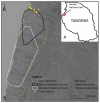Antimicrobial Resistance Creates Threat to Chimpanzee Health and Conservation in the Wild
- PMID: 33920028
- PMCID: PMC8071057
- DOI: 10.3390/pathogens10040477
Antimicrobial Resistance Creates Threat to Chimpanzee Health and Conservation in the Wild
Abstract
Infectious disease is recognized as the greatest threat to the endangered chimpanzees made famous by the groundbreaking work of Dr. Jane Goodall at Gombe National Park (GNP), Tanzania. The permeable boundary of this small protected area allows for regular wildlife-human and wildlife-domestic animal overlap, which may facilitate cross-species transmission of pathogens and antimicrobial resistance. Few studies have examined the prevalence of antimicrobial resistance in wild ape populations. We used molecular techniques to investigate the presence of genes conferring resistance to sulfonamides (often used to treat diarrheal illness in human settings in this region) and tetracycline (used in the past-though much less so now) in fecal specimens from humans, domestic animals, chimpanzees, and baboons in and around GNP. We also tested stream water used by these groups. Sulfonamide resistance was common in humans (74%), non-human primates (43%), and domestic animals (17%). Tetracycline resistance was less common in all groups: humans (14%), non-human primates (3%), and domestic animals (6%). Sul resistance genes were detected from 4/22 (18%) of streams sampled. Differences in sul gene frequencies did not vary by location in humans nor in chimpanzees.
Keywords: AMR; Gombe; Tanzania; one health; primate; sulfonamides; tetracycline; zoonoses.
Conflict of interest statement
The authors declare no conflict of interest. The funders had no role in the design of the study; in the collection, analyses, or interpretation of data; in the writing of the manuscript, or in the decision to publish the results. The findings and conclusions in this report are those of the authors and do not necessarily represent the official position of the Centers for Disease Control and Prevention.
Figures
Similar articles
-
The Gombe Ecosystem Health Project: 16 years of program evolution and lessons learned.Am J Primatol. 2022 May;84(4-5):e23300. doi: 10.1002/ajp.23300. Epub 2021 Jul 5. Am J Primatol. 2022. PMID: 34223656 Free PMC article. Review.
-
Epidemiology and molecular characterization of Cryptosporidium spp. in humans, wild primates, and domesticated animals in the Greater Gombe Ecosystem, Tanzania.PLoS Negl Trop Dis. 2015 Feb 20;9(2):e0003529. doi: 10.1371/journal.pntd.0003529. eCollection 2015 Feb. PLoS Negl Trop Dis. 2015. PMID: 25700265 Free PMC article.
-
The contribution of long-term research at Gombe National Park to chimpanzee conservation.Conserv Biol. 2007 Jun;21(3):623-34. doi: 10.1111/j.1523-1739.2007.00704.x. Conserv Biol. 2007. PMID: 17531041
-
Research and Conservation in the Greater Gombe Ecosystem: Challenges and Opportunities.Biol Conserv. 2020 Dec;252:108853. doi: 10.1016/j.biocon.2020.108853. Epub 2020 Nov 16. Biol Conserv. 2020. PMID: 33343005 Free PMC article.
-
Pathogen Transmission from Humans to Great Apes is a Growing Threat to Primate Conservation.Ecohealth. 2018 Mar;15(1):148-162. doi: 10.1007/s10393-017-1306-1. Epub 2018 Jan 23. Ecohealth. 2018. PMID: 29362964 Review.
Cited by
-
The Gombe Ecosystem Health Project: 16 years of program evolution and lessons learned.Am J Primatol. 2022 May;84(4-5):e23300. doi: 10.1002/ajp.23300. Epub 2021 Jul 5. Am J Primatol. 2022. PMID: 34223656 Free PMC article. Review.
-
An Epidemiologic Study of Bacterial Culture and Antibiotic Susceptibility Analyses in Captive Macaques and Marmosets at the Wisconsin National Primate Research Center.J Am Assoc Lab Anim Sci. 2024 Apr 22;63(5):540-51. doi: 10.30802/AALAS-JAALAS-23-000079. Online ahead of print. J Am Assoc Lab Anim Sci. 2024. PMID: 38649259
-
Antimicrobial susceptibility profile of oral and rectal microbiota of non-human primate species in Ghana: A threat to human health.Vet Med Sci. 2023 Sep 21;10(2):e1271. doi: 10.1002/vms3.1271. Online ahead of print. Vet Med Sci. 2023. PMID: 37733757 Free PMC article.
References
-
- Byarugaba D.K., Kisame R., Olet S. Multi-drug resistance in commensal bacteria of food of animal origin in Uganda. Afr. J. Microbiol. Res. 2011;5:1539–1548.
-
- Bartoloni A., Benedetti M., Pallecchi L., Larsson M., Mantella A., Strohmeyer M., Bartalesi F., Fernandez C., Guzman E., Vallejos Y., et al. Evaluation of a rapid screening method for detection of antimicrobial resistance in the commensal microbiota of the gut. Trans. R. Soc. Trop. Med. Hyg. 2006;100:119–125. doi: 10.1016/j.trstmh.2005.06.027. - DOI - PubMed
Grants and funding
LinkOut - more resources
Full Text Sources
Other Literature Sources
Research Materials
Miscellaneous


